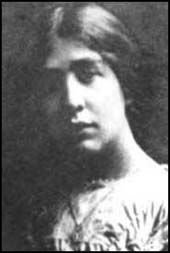 |
![]() Sylvia Pankhurst was the daughter of Suffragette co-founder Emmeline Pankhurst. Sylvia, alone with her sister, Christabel, became a driving member of the movement but left it to create a party that enveloped her own socialist views alongside her views on women’s rights.
Sylvia Pankhurst was the daughter of Suffragette co-founder Emmeline Pankhurst. Sylvia, alone with her sister, Christabel, became a driving member of the movement but left it to create a party that enveloped her own socialist views alongside her views on women’s rights.
Sylvia was born in Manchester on May 5th 1882. Her father was a radical socialist and his teachings stayed with Sylvia for life. She went to Manchester High School for Girls and in 1900 won a place at the Royal College of Art in South Kensington. She developed a friendship with Keir Hardie, the founder of the Independent Labour Party.
In 1906, Sylvia became a full-time worker for the WSPU – Women’s Social and Political Union – that had been founded by her mother and sister in 1903. The WSPU had one simple goal – to have equal voting rights with men. However, during this time she maintained an interest with the Labour movement. In 1906, Sylvia went to prison for the first time.
She started to argue with her mother and Christabel over the direction the WSPU was taking pre-1914. She was very much against the WSPU touting itself towards the middle class at the expense of the working class.
In 1913, she left the WSPU and, helped by Keir Hardie, set up her own organisation. This was first called the East London Federation of Suffragettes but later changed to Women’s Suffrage Federation and then to the Workers’ Socialist Federation. The names alone gave a clear hint as to the political leanings of the organisation, whichever name it had at any given time.
During World War One, Emmeline Pankhurst urged her followers in the WSPU to do ‘their bit’ for the country in its time of need and to show their patriotism. Sylvia, on the other hand, urged her followers not to support the war effort. Some members of the WSF took to hiding conscientious objectors so that they escaped detection by the police.
The WSF continued towards the left and eventually adopted the title ‘Communist Party (British Section of the Third International)’. This was not the official British Communist Party and eventually the ‘Communist Party (British Section of the Third International)’ was absorbed into the official Communist Party of Great Britain. However, Sylvia’s association with this party did not last long. When the Communist Party of Great Britain told Sylvia to hand over her newspaper (‘Workers’ Dreadnought’) to them, she refused and was expelled from the party. She created the Communist Workers’ Party as a rival to the Communist Party of Great Britain. This folded in 1924.
Sylvia toured Europe speaking at left wing meetings and even visited Lenin’s Russia. Sylvia openly spoke out on why she disagreed with some of the policy statements Lenin had made – especially on censorship.
In 1927, Sylvia gave birth to a boy. She refused to marry the father and her mother, Emmeline, was so angered by this that she had no further contact with her daughter.
In the mid-1930’s Sylvia took up the cause of Ethiopia. She became a fervent supporter of Haile Selassie and in 1936 set up the ‘New Times and Ethiopian News’ to keep the British public alert as to what was happening in Ethiopia after the invasion by Mussolini’s Italy. Sylvia’s work for Ethiopia attracted the attention of MI5 and they continued monitoring her work after World War Two when she pushed for a re-union between Italian Somaliland and Ethiopia. One MI5 brief referred to Sylvia as “tiresome” as they tried to find ways to quieten her down. She became an advisor to Haile Selassie and in 1956 moved to Addis Ababa. Here she founded the ‘Ethiopian Journal’ that reported on life in Ethiopia.
Sylvia died in Ethiopia on September 27th 1960 and was given a state funeral and is buried in the Holy Trinity Cathedral. At her funeral Haile Selassie named her an ‘honorary Ethiopian’.
